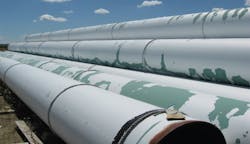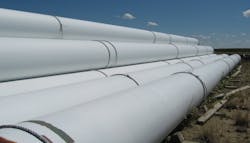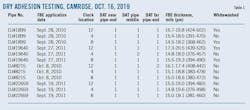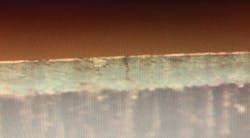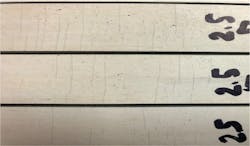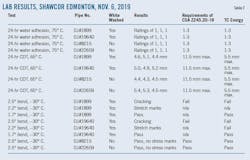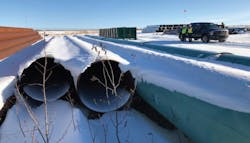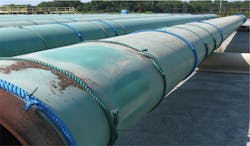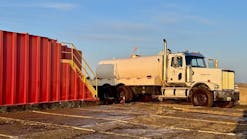Keith E. W. Coulson
James Ferguson
TC Energy
Calgary
With the exception of reducing some of its flexibility, whitewash-protected fusion-bond epoxy (FBE) coatings exposed to ultraviolet (UV) light in Canada for as long as 10 years retained many of their original properties and attributes. FBE coatings that were completely protected from any UV exposure still possessed all original coating thickness and physical traits.
Even after nearly a decade, the use of whitewash UV protective coatings in Canada has proven to be extremely successful in preserving and retaining the original dry-film thicknesses (DFT) of the FBE coating. Apart from a slight reduction in coating elasticity, whitewash UV protective coatings preserved many of the other physical characteristics of the underlaying FBE coating as well. Unlike in the southern US, whitewash coated pipe stockpiled in Canada appeared to retain enough flexibility to enable the pipe to be classified as fit for purpose. The lower intensity of UV levels in Canada, as contrasted to those in the southern US, played a part. The fact that the Canadian pipe was covered with snow for at least a few months of the year also resulted in reduced UV exposure and hence a lower likelihood of embrittlement than experienced in the southern US.
Background
Results of a recent evaluation program by TC Energy on the coating integrity of stockpiled pipe in the US concluded that FBE pipe coatings from the outer layers of the stockpiles with UV-protected whitewash coating maintained all but elasticity characteristics, while pipe stored in the internal layers that had been protected from the direct exposure to UV rays and weathering maintained all its original properties and performance levels. Field and laboratory appraisals demonstrated that the properties of the internally stored pipe coating mirrored those achieved during manufacture and hence the coating was still entirely compliant with the requirements and criteria of both company and national standards.
The Keystone XL pipeline project assessed in these studies is part of an expansion to the Keystone pipeline. The project comprises about 530 km (329 miles) in Canada, with the US system adding just more than 1,400 km (870 miles) of pipeline to connect with refining hubs in Illinois, Oklahoma, and the Gulf Coast of Texas. The FBE coated line pipe for the project was procured, manufactured, and coated in 2009, 2010 and 2011. The pipe was then stockpiled in large quantities at several sites throughout Canada and the US. Once stockpiled, most of the FBE coated pipe remained unused until an inspection and remediation program was initiated in August 2018.
This article describes the second portion of this overall refurbishment program of pipe stored within North America and deals specifically with pipe in Canada. In this part of the program, the inspection and testing of each critical coating feature assessed the integrity of stockpiled pipe coating stored for nearly a decade throughout various sites within Western Canada. This information could then be used to both examine the consequences of long-term storage on pipe coatings and predict if the storage procedures maintained the FBE coating as still ‘fit for purpose.’ The results of this engineering inspection of Canadian stockpiled pipe coatings was also compared and correlated with the conclusions of the previous US restoration study (OGJ, Jan. 6, 2020, p. 52), thereby determining if the practice of stockpiling pipe in the US and Canada is likely to produce varying or similar outcomes in respect to UV and weathering coating degradation.
UV exposure effects
When exposed to UV rays, FBE coatings undergo polymer degradation commonly referred to as chalking. This phenomenon is common to all FBE coatings that are primarily designed only for below ground service. If undisrupted, this layer of chalked FBE will protect the underlaying FBE and enable the coating to retain most of its original properties.1 If this protective layer of chalked coating is removed, however, the new surface will undergo this repeated process of chalking. Previous field studies demonstrated that as this breakdown continues, it is accompanied by a noticeable reduction in coating thickness of 10-40 µm/year (OGJ, Apr. 16, 2001, p. 58).1 The actual degree to which this coating thickness reduction occurs depends on the following factors:
- Ability of the FBE coating’s formulation to resist UV breakdown.
- The amount of exposure to UV. The amount of exposure could be determined by the pipe’s position in the stockpile and the duration of storage.
- The intensity of direct exposure to the elements; UV intensity in areas of the southern US would be far greater than those in Canada.2
- Exposure to moisture via rainfall.
- Periods of protection from UV exposure by snow cover.
All instances of direct FBE coating exposure to UV show a reduction of the coating’s original flexibility when examined in accordance with the Canadian Standards Association (CSA) Z245.20 cold temperature flexibility test method.3 This aesthetic change of gloss is usually accompanied by an embrittlement of the coating as exhibited by loss of adhesion when examined using the dry adhesion test (DAT). As such, any form of reducing exposure to UV would be beneficial in reducing or eliminating UV damage to the polymeric structure of the FBE.
Pipe data, storage
Specific pipe sections representative of the pipe stocks underwent evaluation. Pipe and coating conformed to:
- 36-in. (914-mm) OD × 0.465-in. (11.8-mm) WT, API Spec 5L (44th Edition), PSL 2 PSL Grade X70 (483) SAWH pipe coated externally with FBE to the requirements of CSA Z245. 20 System 1A, but without the application of an acrylic UV deterioration mitigation system (whitewash).
- Same pipe and FBE coating but with an outer layer of post-coating applied whitewashed UV deterioration mitigation acrylic paint on exposed areas.
- All the pipe addressed in this Canadian study was manufactured by JFE Steel Corp., Japan, and FBE coated at ShawCor Ltd., Toronto, with KCC Karumel EX4413-F103. The subsequent whitewash coatings were applied in the field.
This piping was generally stored four or five high with 19 mm ropes used as separators (Fig. 1).
Stockpile locations in Canada included:
- Bindloss, Alta.
- Camrose, Alta.
- Monitor, Alta.
- Oyen, Alta.
- Piapot, Sask.
- Regina, Sask.
- Shaunavon, Sask.
In Canada, the whitewashed pipe at the storage sites constitutes about 20% of the just more than 28,000 joints of 24-m lengths stockpiled for this project. This Canadian pipe had been stored for 24-36 months before the first application of whitewash coating. This coating was reapplied once after about 4 years.
In all cases, all exposed areas of FBE coating were whitewashed with the exceptions of some uncoated windows to retain the external stencil and pipe identification markings on each pipe end. As the pipe markings were transposed to the internal surface as required by CSA standards, most pipes were then fully whitewashed from FBE pipe cutback-to-cutback with UV-resistant acrylic paints.
In most cases after replenishing, the whitewash acrylic resin coating in Canada appeared not to have significantly faded. This was unlike in the US where significant whitewash fading was commonly observed. In some of the Canadian stockpiles, however, there were examples of whitewash adhesion failures and coating delamination (Fig. 2). This whitewash coating delamination reduced the effectiveness of the whitewash to resist UV degradation as was exhibited by the loss of coating thickness at these specific delamination points.
While the root cause of this whitewash coating delamination was not firmly established, probable causes include likely pipe handling damage or most likely ineffective coating preparation or application procedures. But in general, the condition of the whitewash coating was still excellent even after nearly 10 years’ exposure. An example of the excellent condition of the whitewashed coating in Canada can be seen in Fig. 3.
Assessment protocol
This refurbishment assessment sought firstly to determine the effects in Canada that weathering had on the pipe underneath the whitewash and to ascertain the quality of its FBE coating and secondly to establish a benchmark performance criterion for the coating on pipes stored internally in the stockpile and not exposed to UV.
A coating inspection and test plan (ITP) assessed the pipe coating’s integrity. The examination looked at:
- FBE coating that had been coated with whitewash acrylic UV protective coatings.
- FBE coating from pipes stored in the internal segments of the stockpile that was not exposed to UV.
The coating ITP stipulated the following testing activities:
- Documentation of pipe numbers and their correlation to location in the stockpile for selected pipe piles.
- Performance assessment of DFT on selected pipe. Frequency and location on pipe to be determined and documented, for example 12, 4, and 8 o’clock positions.
- Performance assessment of DAT in accordance with ISO 21809-3: Annex Q: Adhesion Test.4
- Performance assessment of holiday detection inspection on selected pipes.
- Testing of selected pipe at laboratories in Canada.
Assessment objective
The assessment had three objectives. It sought to enumerate the correlation between DFT and DAT techniques with the integrity assessment evaluations stipulated in CSA Z245.20-18. By conducting a series of laboratory tests, assessment hoped to establish to regulators that dry adhesion and dry thickness testing quantifies the quality of FBE coatings being held at the stockpiles. It also sought to confirm the expected conclusion that the whitewashed and non-UV-exposed FBE coating were still fit for below ground anti-corrosion purposes.
Assessment program results
Initially, two lengths of pipe that had been whitewashed and stored on the outside layers of the stock piles underwent assessment. Two joints that had not been whitewashed and stored in the interior of the stockpiles were also removed and assessed as specified in the ITP defined in the protocol for assessment. The four joints were quarantined at ShawCor’s Camrose, Alta., internal coating plant and subjected to an intensive inspection for DFT along with dry adhesion testing. The testing took place inside the plant to minimize effects of inclement weather and provide consistent testing conditions (Fig. 4). Temperatures within the plant during this inspection process were consistently recorded as 14-15° C. (57-59° F.). These temperatures were identical to the test temperatures in the US evaluations at Little Rock, Ark. The Canadian coated test pipes then underwent laboratory evaluation.
Table 1 shows results of DAT and DFT testing for all four pipe joints. Each joint was quarantined and tested at three separate points along each pipe. At each testing site DAT and DFT testing was completed at 12, 4, and 8 o’clock positions. This was repeated at sites near the end of each joint and at its midway point.
All the piping that had been whitewashed still had acceptable coating thickness measurements. The company’s coating specification stipulated a requirement of 356-506 µm of FBE coating during manufacture. A range of 401-502 µm was recorded on the whitewashed coating, putting it completely in the range originally stipulated, the only exception being DJ#1899 where one low reading of 368 mm was noted.
The DATs performed on those whitewashed and non-whitewashed pipes consistently met the minimum requirements expected of this coating. Table 1 illustrates that all 36 DAT tests conducted on the four-test pipes attained acceptable DAT ratings of 1 or 2. All but two of each of the tests produced a prefect rating of 1. The remaining two tests exhibited a rating of 2. Subsequent testing at ShawCor’s Edmonton laboratory focused on test rings from each of these four pipes.
Laboratory assessments
Assessment of whitewashed and non-whitewashed coated pipe followed CSA Z245.20-18 Table 2 criteria:
- 2.5° flexibility testing at −30° C. If unsuccessful, reduced degrees of bend testing were introduced.
- 24-hr cathodic disbondment test at 3.5 v and 65° C.
- 24-hr water soak adhesion test at 75° C.
Additional 1.5° flexibility testing at −30° C. (three specimens, in accordance to TC Energy’s requirements), was included to examine and check for any stress, strain, or pigment migration markings.
As with the US program, the use of differential scanning calorimetry was not considered for this program because of the potential moisture absorption has to produce misleading thermal test results (OGJ, Feb. 24, 1986, pp. 63)
Laboratory testing
With exception of the flexibility result, whitewashed pipe ends exposed to UV were totally acceptable. The whitewash-protected coatings fared well with cathodic disbondment testing (CDT) results of between 4.4 to 5.2 mm disbondment (Fig. 5), and water soak adhesion ratings of 1. The flexibility tests were initially deemed failures on the UV-exposed whitewashed pipe (Figs. 6-7). The testing degree per pipe diameter length of pipe was reduced from 2.5° to 2.2° but still showed some coating distress. At 1.7°, however, the coatings demonstrated enough flexibility to pass the bend test at −30° C.
The CSA flexibility test method reflects the temporary angle of deflection and not the total plastic or permanent bend or angle of deformation. A percentage of overstain submitted in the laboratory bend test does not reflect those seen by the coating during cold field-bend operations.5 As such, in the experiments conducted in this UV exposure study, it is critical to understand that the 2.5° and 1.7° CSA tests represent a plastic deformation of 1.9° and 1.1°, respectively. By passing the 1.7° CSA cold bend test, the coating exhibited enough flexibility to successfully undergo a field bend of 1.1°.
Care must be taken when interpreting these laboratory test results as they cannot simply be substituted for a projection of field bend performance. To correctly identify what coating materials can do in the field, there must be proper and consistent analysis of the level of strain and the plastic deformation of the coating. This approach was applied in this study and, therefore, the forecast compatibility of the coating materials to mimic field performance may be considered correct.
The whitewashed coatings in the US that were exposed to UV suffered significant reductions in their flexibility traits. After the same period of weathering, however, the exposed whitewashed coatings in Canada appeared to retain nearly 60% of their original elastic characteristics.
Non-UV-exposed pipe
The laboratory test results on non-ultraviolet exposed pipe proved to be excellent. The results clearly demonstrate the FBE coating that was not exposed to UV or weathering was still totally fit for purpose and retained all the properties exhibited at its production (Tables 1-2). Examples of CDT test results for of both whitewashed and non-whitewashed coating are shown in Fig. 5.
Canadian stockpiled pipes
Canadian coated pipe tested from the internal areas of the stockpile, and thus not exposed to weathering, was totally fit for purpose, passing all required CSA tests.
The Canadian whitewash coating exhibited good retention of coating thickness, dry adhesion properties, and cathodic disbondment and hot water soak adhesion characteristics. But flexibility of the underlaying FBE was slightly affected. Unlike that in the southern US, however, flexibility did not reach the point where the coating was no longer acceptable for exposure to field bending. The depression of the coating’s flexibility levels could have been caused by a combination of the following factors:
- The alternate absorption of moisture in damp weather and its release in dry weather can have serious effects on coating properties.6 While this was true for both Canada and the US, the protective layer of snow in the winter reduced these fluctuations in Canada and hence diminished the impact of this moisture absorption phenomenon. The elevated temperatures in the US would also accelerate those moisture absorption and release cycles leading to far earlier breakdown of the underlaying FBE coating than was noted in Canada.
- Figs. 8-9 illustrate the difference in the condition of the coating when stored in Camrose, Alta., and Little Rock, Ark. The blanket of snow in Canada acts as nature’s sunscreen in reducing the intensity of the UV rays and inhibiting the moisture absorption and release cycles that were more prevalent in Little Rock.
- Another factor, according to a study conducted by New Zealand’s National Institute of Water and Atmospheric Research is that the UV intensity in Canada is far less than in the southern US, leading to a slower breakdown of exposed FBE coatings.2
The whitewashed protective coating in Canada was originally applied months after the pipe was coated. In the intervening years, there was only one other application of this whitewash coating. Unlike in the US, however, where the whitewashed coating suffered significant fading, even after 4-5 years’ exposure to the elements, the whitewash coating in Canada appeared to be in very good condition (Fig. 3). It is therefore unlikely that in Canada any additional applications of whitewash coatings would have contributed to a total retention of the elastic properties of the parent FBE coating.
References
- Kehr, J.A., ‘Fusion Bonded Epoxy, A Foundation for Pipeline Corrosion,’ NACE International, Houston, Texas, 2003.
- Liley, J.B. and McKenzie, R.L., ‘Where on Earth has the highest UV?’ National Institute of Water and Atmospheric Research (NIWA), Lauder, Central Otago, New Zealand, 2006.
- Canadian Standards Association, ‘Plant-Applied External Fusion Bond Epoxy Coating for Steel Pipe,’ CSA Z245.20-18, Toronto, Sept. 1, 2018.
- International Standards Organization ISO 21809-3, ‘Petroleum and natural Gas Industries – external Coatings for Buried or submerged Pipelines Used in Pipeline Transportation Systems- Part 3: Field Joint Coatings: Annex Q: Adhesion Test – Resistance to Removal,’ ISO Switzerland, March 1, 2016.
- Coulson, K.E.W. and Temple, D.G., ‘An Independent Laboratory Evaluation of External Pipeline Coatings,’ 5th International Conference on Internal and External Protection of Pipes, Innsbruck, Austria, October 25-27, 1983.
- Evans, U.R., ‘Metallic Corrosion Passivity and Protection,’ Edward Arnold Publishers, London, UK, p. 637, 1948.
Acknowledgements
The authors would like to acknowledge the contribution of Neil Johnson, plant coordinator of ShawCor, Camrose, and Brian Pacholik, operations manager Canada for ShawCor to the success of this program. Thanks to Jon French, Landon Miller (both ShawCor Camrose) and James Coulson (Dragon Pipeline Specialists) for facilitating the test pipe and then undertaking the actual physical inspection and testing of the quarantined test sections. Also, a special thanks to Jeff Telford and Nauman Hehmood of ShawCor Edmonton for their diligent laboratory assessments. Credit also to Heather Traub and Kat McTavish of TC Energy, Calgary, for graphic and editorial support. Finally, acknowledgements and appreciation to Eric Shelton (former vice president of TC Energy) for his support with developing pipe coating testing and championing the use of national and international standards for pipe coating testing and specifications, such as the ones used in this study.
The authors
Keith E. W. Coulson ([email protected]) is a technical consultant with TC Energy, Calgary. He was previously the technical vice-president of Jotun, Norway, after spending 22 years at TC Energy as pipeline corrosion specialist. Keith was educated at the University of Swansea, Wales, and the University of Aston, England, where he attained his master’s degree. He has more than 40 years of experience in the oil and gas industry and has authored in excess of 30 published technical papers on pipeline integrity, stress corrosion cracking, quality management, and pipeline materials. He is a Registered Professional Engineer in Alberta, a Fellow of the Institute of Corrosion (UK) and a registered NACE Corrosion Specialist. He is also licensed as a European Engineer (Eur Ing). Keith is the former head of the Canadian delegation to the International Standards Organization (ISO) on pipeline materials and past chair of the Canadian Standards Association (CSA) on pipeline coatings.
James Ferguson is a director with TC Energy, Calgary. He has been with TC Energy 14 years, during which he has performed several different roles—including pipeline integrity, construction, and technical support—and provided expertise within TC Energy for materials and welding. James holds a BS in materials engineering from the University of Alberta and is a Registered Professional Engineer with Association of Professional Engineers and Geoscientists of Alberta (APEGA).

